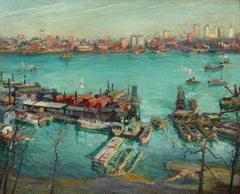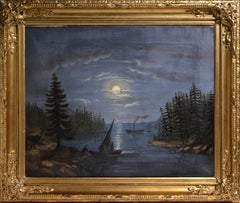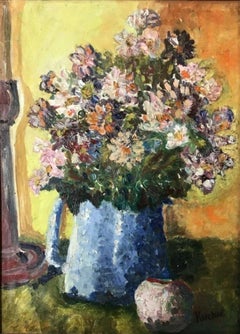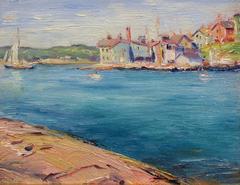Max Kuehne Art
American, 1880-1968
Born in Halle, Germany in 1880, Max Kuehne was a colorist who created cheerful landscapes that appear to be painted spontaneously and with freshness.
He studied with William Merritt Chase and Kenneth Hayes at the Chase School in New York. In 1910, he embarked on a bicycling trip, traveling through England, France, Germany, Holland and Belgium. To support this trip he did portrait commissions along the way.
When he returned to New York City, he set up a studio in Greenwich Village and was a student of Robert Henri from whom he learned a dark impressionist style. He also became close with such avant garde artists as Guy Pene du Bois, William Glackens, William Zorach and Maurice and Charles Prendergast, which also influenced his dark work including street scenes and docks in New York City. However, three years in Spain, and painting trips to Gloucester lightened his palette as did time in Paris where he was much influenced by the Fauves, Nabis, and decorative painters. By 1912 he was producing work that would make him known as a "colourist of great distinction" by producing "paintings full of sparkling sunlight."
He became a member of the artistic community later in Rockport, Massachusetts, with Gifford Beal, Leon Kroll, Paul Manship, Edward Hopper and Jonas Lie. Many of his finest paintings done later in his career are of the busy harbors and piers of Gloucester and Rockport.
His work was widely exhibited including the National Academy of Design, the Art Institute of Chicago, and the Carnegie Institute in Pittsburgh.(Biography provided by Helicline Fine Art)
to
1
3
3
3
2
1
Overall Height
to
Overall Width
to
2
1
1
1
1
3
1
1
5
6,997
3,373
2,513
1,212
3
2
1
1
1
Artist: Max Kuehne
New York Skyline
By Max Kuehne
Located in New York, NY
Max Kuehne paints a dockyard across the river from the skyscrapers of New York City in his artwork entitled, “New York Skyline”
Category
1920s Max Kuehne Art
Materials
Canvas, Oil
Provincetown
By Max Kuehne
Located in Milford, NH
A colorful impressionist coastal oil painting of Provincetown by German / American artist Max Kuehne (1880-1968). Kuehne was born in Halle, Germany, and emigrated to Flushing, New Y...
Category
Mid-20th Century American Impressionist Max Kuehne Art
Materials
Panel, Oil
"Train Station, " Max Kuehne, Industrial City Scene, American Impressionism
By Max Kuehne
Located in New York, NY
Max Kuehne (1880 - 1968)
Train Station, circa 1910
Watercolor on paper
8 1/4 x 10 1/4 inches
Signed lower right
Provenance:
Private Collection, Illinois
Max Kuehne was born in Halle, Germany on November 7, 1880. During his adolescence the family immigrated to America and settled in Flushing, New York. As a young man, Max was active in rowing events, bicycle racing, swimming and sailing. After experimenting with various occupations, Kuehne decided to study art, which led him to William Merritt Chase's famous school in New York; he was trained by Chase himself, then by Kenneth Hayes Miller. Chase was at the peak of his career, and his portraits were especially in demand. Kuehne would have profited from Chase's invaluable lessons in technique, as well as his inspirational personality. Miller, only four years older than Kuehne, was another of the many artists to benefit from Chase's teachings. Even though Miller still would have been under the spell of Chase upon Kuehne's arrival, he was already experimenting with an aestheticism that went beyond Chase's realism and virtuosity of the brush. Later Miller developed a style dependent upon volumetric figures that recall Italian Renaissance prototypes.
Kuehne moved from Miller to Robert Henri in 1909. Rockwell Kent, who also studied under Chase, Miller, and Henri, expressed what he felt were their respective contributions: "As Chase had taught us to use our eyes, and Henri to enlist our hearts, Miller called on us to use our heads." (Rockwell Kent, It's Me O Lord: The Autobiography of Rockwell Kent. New York: Dodd, Mead and Co., 1955, p. 83). Henri prompted Kuehne to search out the unvarnished realities of urban living; a notable portion of Henri's stylistic formula was incorporated into his work.
Having received such a thorough foundation in art, Kuehne spent a year in Europe's major art museums to study techniques of the old masters. His son Richard named Ernest Lawson as one of Max Kuehne's European traveling companions. In 1911 Kuehne moved to New York where he maintained a studio and painted everyday scenes around him, using the rather Manet-like, dark palette of Henri.
A trip to Gloucester during the following summer engendered a brighter palette. In the words of Gallatin (1924, p. 60), during that summer Kuehne "executed some of his most successful pictures, paintings full of sunlight . . . revealing the fact that he was becoming a colorist of considerable distinction." Kuehne was away in England the year of the Armory Show (1913), where he worked on powerful, painterly seascapes on the rocky shores of Cornwall. Possibly inspired by Henri - who had discovered Madrid in 1900 then took classes there in 1906, 1908 and 1912 - Kuehne visited Spain in 1914; in all, he would spend three years there, maintaining a studio in Granada. He developed his own impressionism and a greater simplicity while in Spain, under the influence of the brilliant Mediterranean light. George Bellows convinced Kuehne to spend the summer of 1919 in Rockport, Maine (near Camden). The influence of Bellows was more than casual; he would have intensified Kuehne's commitment to paint life "in the raw" around him.
After another brief trip to Spain in 1920, Kuehne went to the other Rockport (Cape Ann, Massachusetts) where he was accepted as a member of the vigorous art colony, spearheaded by Aldro T. Hibbard. Rockport's picturesque ambiance fulfilled the needs of an artist-sailor: as a writer in the Gloucester Daily Times explained, "Max Kuehne came to Rockport to paint, but he stayed to sail." The 1920s was a boom decade for Cape Ann, as it was for the rest of the nation. Kuehne's studio in Rockport was formerly occupied by Jonas Lie.
Kuehne spent the summer of 1923 in Paris, where in July, André Breton started a brawl as the curtain went up on a play by his rival Tristan Tzara; the event signified the demise of the Dada movement. Kuehne could not relate to this avant-garde art but was apparently influenced by more traditional painters — the Fauves, Nabis, and painters such as Bonnard. Gallatin perceived a looser handling and more brilliant color in the pictures Kuehne brought back to the States in the fall. In 1926, Kuehne won the First Honorable Mention at the Carnegie Institute, and he re-exhibited there, for example, in 1937 (Before the Wind). Besides painting, Kuehne did sculpture, decorative screens, and furniture work with carved and gilded molding. In addition, he designed and carved his own frames, and John Taylor Adams encouraged Kuehne to execute etchings. Through his talents in all these media he was able to survive the Depression, and during the 1940s and 1950s these activities almost eclipsed his easel painting. In later years, Kuehne's landscapes and still-lifes show the influence of Cézanne and Bonnard, and his style changed radically.
Max Kuehne died in 1968. He exhibited his work at the National Academy of Design, the Art Institute of Chicago, the Carnegie Institute in Pittsburgh, the Memorial Art Gallery of the University of Rochester, and in various New York City galleries. Kuehne's works are in the following public collections: the Detroit Institute of Arts (Marine Headland), the Whitney Museum (Diamond Hill...
Category
1910s American Impressionist Max Kuehne Art
Materials
Paper, Watercolor
Related Items
Untitled (Farm in Winter)
By Julius M. Delbos
Located in Los Angeles, CA
This work is part of our exhibition America Coast to Coast: Artists of the 1940s
Untitled (Farm in Winter), 1940s, oil on canvas, signed lower right, 26 x 30 inches, presented in an original frame
Julius Delbos...
Category
1940s American Modern Max Kuehne Art
Materials
Canvas, Oil
Idyllic Moon Night Landscape Scandinavian Lakeland 19th century Oil Painting
Located in Stockholm, SE
Nocturnal landscape exudes a sense of calm and serenity, drawing you in with its Naïve Romanticism manner, captured in oils by an unknown artist in the late 19th century. In the fore...
Category
Late 19th Century Realist Max Kuehne Art
Materials
Canvas, Wood, Cotton Canvas, Oil
In the Meadow, Springtime Dutch
By Cornelis Bouter
Located in Hillsborough, NC
Springtime, 'In the Meadow' by Cornelis Bouter (1888-1966) is a Dutch painting with figures and landscape in an impressionist style with early spring blossoms. Idyllic scene by a river under tree blossoms, this fine oil on canvas painting is very well presented in an original frame. Children play while mother peels apples in a pleasant afternoon setting. Sure to please this Easter!
Imported by Saltire...
Category
Early 20th Century Impressionist Max Kuehne Art
Materials
Canvas, Oil
Silver Plume, Colorado, Framed Colorado Mountain Landscape Oil Pastel Drawing
By Elsie Haddon Haynes
Located in Denver, CO
Silver Plume, Colorado - near Georgetown, mountain landscape with fall colors, Aspen and Pine trees, river, houses and mountains by early 20th century Co...
Category
1930s American Impressionist Max Kuehne Art
Materials
Oil Pastel, Pastel
H 21.25 in W 24.5 in D 0.75 in
Untitled (Collapsed Shacks)
By Karl Fortress
Located in Los Angeles, CA
Untitled (Collapsed Shacks), c. 1940s, oil on canvas, signed lower left, 20 ½ x 26 ½ inches, presented in a period frame
This work is part of our exhibition America Coast to Coast: ...
Category
1940s American Modern Max Kuehne Art
Materials
Canvas, Oil
Bali Landscape
Located in Columbia, MO
Benjamin Cameron spent 48 years teaching students in Columbia across three different colleges. His own works still hang on the walls around the community and tell a greater story of ...
Category
21st Century and Contemporary American Impressionist Max Kuehne Art
Materials
Watercolor, Archival Paper
Mid Century River Birches Landscape Watercolor
Located in Soquel, CA
Mid Century River Birches Landscape Watercolor
Gorgeous vibrant mid century watercolor on paper painting of river birch trees by artist Eva Collins Marks (American, 20th century),19...
Category
1950s American Impressionist Max Kuehne Art
Materials
Watercolor, Paper
Landscape
By Marcel Emile Cailliet
Located in Los Angeles, CA
Landscape, 1940, oil on canvas, 24 x 20 inches, signed, dated and titled verso: “Marcel Cailliet ’40 – S.C.” and “Marcel Cailliet Landscape”; likely exhibited at the annual juried st...
Category
1940s American Modern Max Kuehne Art
Materials
Canvas, Oil
Canal at Indian Mound Road
By Ben Fenske
Located in Sag Harbor, NY
Painted during the 2015 Winter Equestrian Festival in Wellington, Florida. A black and white depiction of a canal, is barely recognizable, due to Fenske's wild brushstrokes and lack...
Category
21st Century and Contemporary American Impressionist Max Kuehne Art
Materials
Gouache, Paper
Mid Century California Mission Landscape
Located in Soquel, CA
Beautiful mid century landscape of a historic California mission, highlighting its iconic architectural details such as a columned arches, white was...
Category
Mid-20th Century American Impressionist Max Kuehne Art
Materials
Gouache, Cardboard, Paper
The Sailor is a 11 x 8" oil Cuban-American Water Impressionism
By Reynier Llanes
Located in Houston, TX
REDUCED FROM $3000
The Sailor is a 11 x 8" oil painting by Cuban-American artist Reynier Llanes who lives in Miami. It is framed. It is oil painted on a wood panel . The Sailor floats in the frame. The background of Reynier Llanes is unique in style , subject matter, and medium.
The artist says this about Field of Flight The characters in my paintings emerge from stories and their journeys are inspired by my own experiences and daily routines. My inspiration comes from literature, music, cinema, and daily life. My daily routine enables me to meditate and use my creativity to serve these stories and inspirations. I begin my mornings with sketches and watercolors. This is the time I use to keep inventory of my ideas and to allow them to further inspire me. Many of these characters have been depicted in my work before, whether in a different geographical location or in a different state of their physical evolution. I use a variety of mediums in my work including oils, watercolors, coffee, and charcoal. They are all equally important to me as they allow me full expression, each in its’ own sector.
I use a great deal of symbolism in my art to give depth to the subjects that I wish to express. I want my art to tell a story in a manner that stimulates the imaginations of others, especially of things never seen or expressed directly. As an observer it is clear to see that we are all in pursuit of life’s mission of working, loving, and belonging. I begin my paintings by building layers of textures and color values, and then subtly add dimension and depth. Through the use of colors and highlighting I am able to enhance the atmosphere with mood, character, depth and mystery, and bring special attention to my subjects. It is the creative process of using these materials and methods that feed my soul, life, and being. I believe it is our mission as intellectuals to have a voice in our society, for our work to have a footprint in history, and to be a reference for future generations.
BIO:
Reynier Llanes was born in Pinar del Rio, Cuba in 1985. He attended the city’s school of art (Instructores de Arte) for four years and completed his studies in 2004. Llanes was tutored by one of the country’s most recognized realist artists, Juan Miguel Suárez. In 2005 he moved to Havana where he continued his studies and collaborated with various artists. The capital was a thriving mecca of art and culture and the museums the grounds for inspiration.
In 2007 LIanes availed himself of an opportunity to emigrate from Cuba and moved to the United States, first settling in Naples, FL. In Naples he began to introduce his work in a major exhibition entitled “Strange Visitor” at the Kapo Maestro Gallery. In 2009 he relocated to Charleston, SC where he had the honor of being granted an artist in residency at the Jonathan Green Studios.
Llanes was awarded a "first purchase award" for a piece now in the art collection of the city of Charleston 2011 at Moja Art Festival Juried Exhibition Award. In 2012 Oxford America recognized him as one of the "New Superstars of Southern Art." The art of Reynier was nourished by the rich southern culture and he began to collaborate with various museums and art centers. His work was featured in a traveling exhibition The Vibrant Vision Collection at the Morris Museum in Augusta, GA and the Gibbes Museum of Art in Charleston, SC.
Llanes is also an avid art collector in his own right, focusing on works by artists from Cuba, and particularly those from his native province of Pinar del Río. A selection of works from his collection was exhibited at City Gallery in Charleston in 2013 and in the Art Museum in Myrtle Beach in 2015.
In 2015 Llanes relocated with his family to Miami in order to take advantage of the city’s international art market and vibrant cultural life and to be closer to his home country. South Florida is, of course, home to a large community of intellectuals, collectors, and fellow artists who have welcomed Llanes into their cosmopolitan scene. His first solo exhibition in Miami took place at Miami Dade College West, this exhibition was entitled “Preserving Cultural Heritage” and it featured a large collection of coffee paintings.
In 2017 he met Bill Meek...
Category
2010s American Impressionist Max Kuehne Art
Materials
Wood Panel, Oil
H 11 in W 8 in D 1.5 in
Sangre de Cristo Mountains, Southern Colorado Watercolor Landscape Painting
By Alfred Wands
Located in Denver, CO
Vintage original modernist watercolor painting of the Sangre de Cristo Mountain range in Colorado by Alfred Wands (1904-1998). A farm in th...
Category
20th Century American Impressionist Max Kuehne Art
Materials
Watercolor
H 28.25 in W 34 in D 1.25 in
Previously Available Items
"Floral Still Life in a Blue Vase" American Impressionist
By Max Kuehne
Located in New York, NY
Max Kuehne (1880 - 1968)
Floral Still Life
Oil on board
16 x 12 inches
Signed lower right: Kuehne
Provenance:
Wilma and Ronald J. Baird, Philadelphia
Private Collection, Rhode Island
Exhibited:
Philadelphia, Mann Center for Older People, May 1968.
Germantown, Pennsylvania, Young Women's Christian Association, May - June 1973.
Max Kuehne was born in Halle, Germany on November 7, 1880. During his adolescence the family immigrated to America and settled in Flushing, New York. After experimenting with various occupations, Kuehne decided to study art, which led him to William Merritt Chase's famous school in New York; he was trained by Chase himself, then by Kenneth Hayes Miller. Chase was at the peak of his career, and his portraits were especially in demand. Kuehne would have profited from Chase's invaluable lessons in technique, as well as his inspirational personality. Miller, only four years older than Kuehne, was another of the many artists to benefit from Chase's teachings. Even though Miller still would have been under the spell of Chase upon Kuehne's arrival, he was already experimenting with an aestheticism that went beyond Chase's realism and virtuosity of the brush. Later Miller developed a style dependent upon volumetric figures that recall Italian Renaissance prototypes.
Kuehne moved from Miller to Robert Henri in 1909. Rockwell Kent, who also studied under Chase, Miller, and Henri, expressed what he felt were their respective contributions: "As Chase had taught us to use our eyes, and Henri to enlist our hearts, Miller called on us to use our heads." Henri prompted Kuehne to search out the unvarnished realities of urban living; a notable portion of Henri's stylistic formula was incorporated into his work.
Having received such a thorough foundation in art, Kuehne spent a year in Europe's major art museums to study techniques of the old masters. His son Richard named Ernest Lawson as one of Max Kuehne's European traveling companions. In 1911 Kuehne moved to New York where he maintained a studio and painted everyday scenes around him, using the rather Manet-like, dark palette of Henri. He also became close with such avant garde artists as Guy Pene du Bois, William Glackens, William Zorach and Maurice and Charles Prendergast, which also influenced his dark work including street scenes and docks in New York City.
A trip to Gloucester during the following summer engendered a brighter palette. In the words of Gallatin, during that summer Kuehne "executed some of his most successful pictures, paintings full of sunlight . . . revealing the fact that he was becoming a colorist of considerable distinction." Kuehne was away in England the year of the Armory Show (1913), where he worked on powerful, painterly seascapes on the rocky shores of Cornwall. Possibly inspired by Henri - who had discovered Madrid in 1900 then took classes there in 1906, 1908 and 1912 - Kuehne visited Spain in 1914; in all, he would spend three years there, maintaining a studio in Granada. He developed his own impressionism and a greater simplicity while in Spain, under the influence of the brilliant Mediterranean light. George Bellows convinced Kuehne to spend the summer of 1919 in Rockport, Maine (near Camden). The influence of Bellows was more than casual; he would have intensified Kuehne's commitment to paint life "in the raw" around him.
After another brief trip to Spain in 1920, Kuehne went to the other Rockport (Cape Ann, Massachusetts) where he was accepted as a member of the vigorous art colony, spearheaded by Aldro T. Hibbard. Rockport's picturesque ambiance fulfilled the needs of an artist-sailor: as a writer in the Gloucester Daily Times explained, "Max Kuehne came to Rockport to paint, but he stayed to sail." The 1920s was a boom decade for Cape Ann, as it was for the rest of the nation. Kuehne's studio in Rockport was formerly occupied by Jonas Lie. He became a member of the artistic community later in Rockport, Massachusetts, with Gifford Beal, Leon Kroll, Paul Manship, Edward Hopper and Jonas Lie. Many of his finest paintings done later in his career are of the busy harbors and piers of Gloucester and Rockport.
Kuehne spent the summer of 1923 in Paris, where in July, André Breton started a brawl as the curtain went up on a play by his rival Tristan Tzara; the event signified the demise of the Dada movement. Kuehne could not relate to this avant-garde art but was apparently influenced by more traditional painters — the Fauves, Nabis, and painters such as Bonnard. Gallatin perceived a looser handling and more brilliant color in the pictures Kuehne brought back to the States in the fall. In 1926, Kuehne won the First Honorable Mention at the Carnegie Institute, and he re-exhibited there, for example, in 1937 (Before the Wind). Besides painting, Kuehne did sculpture, decorative screens, and furniture work with carved and gilded molding. In addition, he designed and carved his own frames, and John Taylor Adams encouraged Kuehne to execute etchings. Through his talents in all these media he was able to survive the Depression, and during the 1940s and 1950s these activities almost eclipsed his easel painting. In later years, Kuehne's landscapes and still-lifes show the influence of Cézanne and Bonnard, and his style changed radically.
Max Kuehne died in 1968. He exhibited his work at the National Academy of Design, the Art Institute of Chicago, the Carnegie Institute in Pittsburgh, the Memorial Art Gallery of the University of Rochester, and in various New York City galleries. Kuehne's works are in the following public collections: the Detroit Institute of Arts (Marine Headland), the Whitney Museum (Diamond Hill...
Category
Mid-20th Century American Impressionist Max Kuehne Art
Materials
Oil, Board, Paint
Sailing Out of Harbor
By Max Kuehne
Located in Wiscasset, ME
Born in Halle, Germany in 1880, artist Max Kuehne studied at William Merritt Chase’s school in New York under Chase, then Kenneth Hayes Miller and in 1909, was a pupil of Robert Henr...
Category
1920s Impressionist Max Kuehne Art
Materials
Oil, Board
A Village Church Near Baya
By Max Kuehne
Located in Fairlawn, OH
Signed by the artist lower right: Kuehne
Signed, dated and titled "A Village Church near Baya (sic)" by the artist in pencil verso.
Category
1920s Max Kuehne Art
Max Kuehne art for sale on 1stDibs.
Find a wide variety of authentic Max Kuehne art available for sale on 1stDibs. You can also browse by medium to find art by Max Kuehne in paint, oil paint, canvas and more. Much of the original work by this artist or collective was created during the 20th century and is mostly associated with the Impressionist style. Not every interior allows for large Max Kuehne art, so small editions measuring 16 inches across are available. Customers who are interested in this artist might also find the work of Donald Teague, William Lester Stevens, and Gifford Beal. Max Kuehne art prices can differ depending upon medium, time period and other attributes. On 1stDibs, the price for these items starts at $2,800 and tops out at $65,000, while the average work can sell for $5,900.





